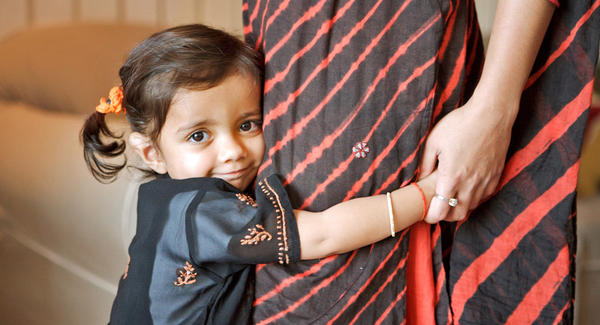Tips To Get Your Shy Child To Be More Sociable
Shyness is a common, but a little misunderstood emotion. Shyness can be defined as a state or quality of being nervous or timid in the company of other people. The basic feeling of shyness is universal, and can be argued to have evolved as an adaptive mechanism used to help individuals cope with social stimuli. Everyone has felt ambivalent or self-conscious in a new social situation. However, there are times when shyness can interfere with optimal social development and can restrict children’s learning. Children may be vulnerable to shyness at particular developmental points.
Perhaps, when a child is born the last thing the parents think about is whether their child be shy or not. Parents pray for their child to be healthy and normal. They keep a track of the child’s height and weight, and record for every milestone of the first words and steps the child achieves. This increased emphasis on motor development, language skills and learning tends to divert attention of parents, teachers and even child psychologists away from the social and emotional growth of children. The Stanford Shyness Clinic, under the guidance of Meg Marnell, Rochelle Kramer and Philip Zimbardo has developed different strategies and tactics that have been proven effective to help shy people to cope with personal problems that shyness poses.
From the point of view of a researcher, shyness is a very fascinating phenomenon. Researchers claim that shyness is at the very core of what it means to be human- where individuals make contact with each other, or where they fail in their efforts to become social beings. Charles Darwin observed shyness to be the recognition of blushing, which according to him is the most peculiar and the most human of all expressions. From an analytical perspective, shyness makes us significantly aware of freedom and its constraints. However, it is also true that shyness is a self-imposed loss of freedom.
Researchers have shown that, some children are more shy than others. While many aspects of shyness are learned, researchers have provided genetic evidence for shyness. However, all shy children get stuck in a vicious cycle that holds them from connecting with other kids. When shy kids are around other kids, they feel like an outsider looking in. These children feel uncomfortable in social settings and hence avoid interacting with their peers. Subsequently, this leads to less practice of talking and playing with other kids. Thus, there is decreased opportunity to develop social skills such as having conversations, resolving arguments, taking turns and figuring out fun things to do together.
Overtime, research on the phenomenon of shyness amongst children has made way for more myths that fall by the edge and curious paradoxes such as the bottled-up rage in the good, shy “pussy cat” boy who makes headlines as a mass murderer- the first naughty deed of his life. This reflects the detached perspective of the researcher gives way to the pain that parents might feel as they watch a shy child desperately wanting to be accepted by other children and yet doesn’t know what steps to take to gain their approval.
Hence, to prevent a child to express greater loneliness in their adolescence due to their shyness, it is crucial to adopt certain strategies that will benefit the child to overcomes his/her shyness from an early age.
- Know your Child: It is important to be sensitive to the child’s interest and feelings. This will build a strong relation with child and will show that you respect the child. This makes the child more confident and less inhibited.
- Avoid labeling your child: “He’s our shy one.” Labels often define who we are and who we believe we can become. A label that you create might haunt the child throughout his life.
- Build Self-Esteem and Confidence: Shy children might have negative self-images and might feel that they will not be accepted. It is important to reinforce shy children for demonstrating skills and encourage their autonomy. Praise them often.
- Develop Social Skills: Opportunities for play with young children in a one-on-one situation may allow shy children to become more assertive. Play with new group of peers permits shy children to make a fresh start and achieve a higher peer status.
- Allow the Shy Child to Warm up to New Situations: Pushing a child in a situation that he or she sees as threatening is less likely to help the child build social skill. Help the child feel secure and provide interesting materials to lure him/her into interactions.
- Encourage the Child to Identify Three Classmates: The child should consider these classmates to be fun to play with. Maybe you can arrange an after-school trip to a park or ice cream shop to see if they make a connection.
- Ask the teacher to give your child some responsibility: Some less outgoing kids tend to blossom if they feel special and important.
- Remember That Shyness is Not All Bad: Not every child needs to be the focus of attention. According to Jones, Cheek and Briggs (1986) some qualities of shyness, such as modesty and reserve, are viewed as positive. As long as the child doesn’t seem excessively uncomfortable or neglected around others, drastic interventions are not necessary.
Please note: The opinions expressed in this post are the personal views of the author. They do not necessarily reflect the views of mycity4kids. Any omissions or errors are the author's and mycity4kids does not assume any liability or responsibility for them.



